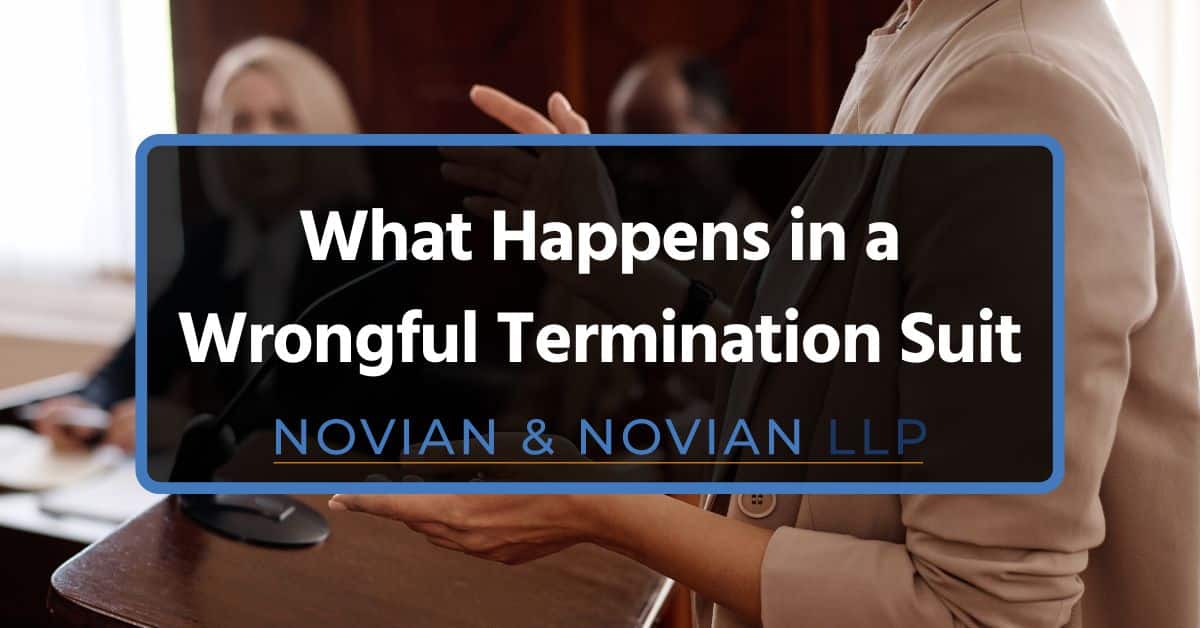
| July 15, 2024 | Employment Law
A wrongful termination lawsuit occurs when an employee believes they have been fired illegally and seeks legal recourse against their employer. This lawsuit starts with the employee filing a complaint in court, and a lot can happen afterward. Sometimes, it could end in settlement negotiations; other times, it extends to court, and a verdict is given.
At Novian & Novian, we specialize in wrongful termination defense for employers. We understand how stressful and complex the process of the lawsuit can be, and we are here to ease you of the stress. With over 30 years of experience, our wrongful termination defense lawyers in California have been providing legal support to protect the rights and interests of employers. Contact us today to get started.
In this blog, we will talk about what a wrongful termination lawsuit is, as well as the details of what the lawsuit entails and the consequences.
What Are Wrongful Termination Lawsuits
Wrongful termination occurs when an employer illegally fires an employee, violating state or federal laws, employment contracts, or public policy. This could be due to discrimination based on race, gender, age, etc., retaliation for whistleblowing, or breach of employment contract.
Wrongful termination claims are harmful to businesses as it comes with financial implications, reputational damage, and operational impact. Typically, litigation can distract management and employees, impacting overall productivity and operations. If you are ever involved in a case of wrongful termination, you need a wrongful termination attorney. A wrongful termination lawyer represents employers accused of wrongful termination. Their role includes legal defense, discovery process, settlement negotiations, and trial representation.
Wrongful Termination in California
In California, wrongful termination claims must adhere to the wrongful termination California statute of limitations. Typically, employees have a limited time to file a lawsuit. The timing varies depending on the nature of the claim.
Both state and federal laws provide protection against wrongful termination. Federal laws include Title VII of the Civil Rights Act, the Age Discrimination in Employment Act, and the Americans with Disabilities Act, while California has additional protections under the Fair Employment and Housing Act (FEHA). As an employer, you must adhere to these laws and ensure you do not terminate employees for illegal reasons. Furthermore, you should maintain thorough documentation and follow proper procedures during terminations.
Keep in mind that the duration of a wrongful termination case can vary widely. It may take several months to a few years, depending on the case’s complexity, the parties’ willingness to settle, and court schedules.
All these factors also add to the cost of wrongful termination. The average cost to defend an employment lawsuit is around $75,000. The cost to defend a wrongful termination lawsuit usually includes attorney’s fees, court costs, and potential settlements or damages.
What Qualifies as Wrongful Termination?
According to both state and federal law, discrimination, retaliation, breach of employment contract, and violation of public policy quality are wrongful terminations. Discrimination includes termination based on race, gender, age, national origin, sexual orientation, or other protected characteristics.
Furthermore, retaliation entails firing an employee for whistleblowing, filing a complaint, or participating in an investigation against the employer. Termination of an employee in violation of terms specified in their employment contract is another form of wrongful termination. Additionally, firing an employee for reasons that violate public policy, such as refusing to commit an illegal act counts as wrongful termination.
What Happens in a Wrongful Termination Suit?
When facing a wrongful termination suit, there are certain steps and processes to follow to ensure you get your desired outcome. The journey typically begins with the plaintiff filing a formal complaint and can lead to various procedures and potential outcomes.
1. Complaint Filed
The wrongful termination suit starts with the plaintiff (terminated employee) filing a formal complaint against the employer. Here, the plaintiff alleges that the termination violated employment laws, breached an employment contract, or was due to discrimination or retaliation.
2. Evaluating the Situation
The next step would be for both parties to evaluate the circumstances of the termination. The plaintiff gathers necessary documentation, witness statements, and other relevant evidence to support their claim while the employer reviews the termination reasons and prepares for a defense.
3. Seeking Legal Advice
As an employer, after reviewing the termination claims filed against you, the ideal thing would be to consult with a wrongful termination attorney. With legal counsel, you can navigate complex employment laws and be sure of proper handling of the case.
Before choosing a lawyer, look for a lawyer with experience in employment law and a track record of handling wrongful termination claims successfully. Furthermore, consider their knowledge of both state and federal laws, their ability to gather and present evidence, and their approach to settlement negotiations and trial representation.
When you choose Novian & Novian, you are sure to get an experienced lawyer who can provide the expertise needed to defend against wrongful termination claims effectively. Contact us now to have a smooth defense process.
4. The Employee’s Claim
On the side of the employee, they prepare their claim by collecting necessary documentation and evidence, such as pay stubs, personnel files, and any communication related to the termination. They must also write a detailed account of the events leading to the termination, outlining how the employer’s actions violated their legal rights.
5. Response to the Complaint
As an employer, you must respond to a wrongful termination claim as soon as possible. In California, the employer’s response involves either admitting or denying the allegations and may include filing motions to dismiss the case or counterclaims against the plaintiff.
6. Discovery Phase
During the discovery process, both parties exchange evidence and information. This phase includes depositions, interrogatories, and requests for documents. Then, each side reviews the collected evidence to build their case for trial.
7. Pre-Trial Motions
Common pre-trial motions include motions to dismiss the case, summary judgment motions, and other requests to resolve the case before trial. Your wrongful termination lawyer will prepare by reviewing evidence, identifying key witnesses, and planning their arguments.
8. Trial
At trial, both sides present their evidence and arguments. This includes witness testimony, documentary evidence, and expert opinions. The trial aims to prove or disprove the claims of wrongful termination.
9. Verdict
The judge or jury delivers the verdict based on the evidence presented. Some possible outcomes include awarding compensatory and punitive damages to the plaintiff if they win, or a judgment in favor of the employer. Understanding the judgment and considering potential appeals is essential for both parties.
10. Post-Trial Actions:
Enforcement of Judgment: If the plaintiff wins, the next step is enforcing the judgment, which involves collecting any damages awarded and ensuring employer compliance with court orders.
Appealing the Decision: Both parties can appeal the decision on specific grounds like irregularities, following appellate court procedures.
Implications for Employers
Facing a wrongful termination claim can have implications for employers. This is why it is best to abide by the law and avoid such cases.
One of the consequences of facing such claims is reinstatement. In some cases, if the court rules in favor of the employee, the employer may be ordered to reinstate the employee to their former position. This can be challenging for the employer, particularly if relationships have soured or if the position has already been filled.
An employer may also face punitive damages in addition to compensatory damages. Punitive damages are intended to punish the employer for particularly egregious conduct. These damages can be substantial and serve as a deterrent to prevent similar behavior in the future. Monetary damages awarded to the plaintiff can include back pay, lost benefits, and compensation for emotional distress. In addition, the employer may be required to cover the plaintiff’s attorney’s fees and court costs. These financial liabilities can add up quickly, putting a strain on the company’s resources.
Furthermore, there would be a decline in the Company’s Reputation. Negative publicity from the case can affect employee morale, deter potential job candidates, and result in loss of business. Thus, maintaining a positive public image becomes more difficult as the company is scrutinized for its employment practices.
What Is the Cost of a Wrongful Termination Lawsuit?
The financial implications of wrongful termination cases for both employees and employers are usually significant. In California, these costs can vary widely depending on several factors, including attorney’s fees, court costs, and potential settlements or damages.
On average, employer defense attorney’s fees range from $300 to $1,500 per hour, depending on the attorney’s experience and the complexity of the case. The total can easily run into tens of thousands of dollars, especially if the case goes to trial, as the cost of a defense settlement goes as high as $75,000 and above. If the plaintiff wins the lawsuit, the employer may be required to pay the plaintiff’s attorney’s fees. This adds another layer of financial burden on the employer.
In addition, filing a wrongful termination lawsuit involves various court fees, including filing fees, service of process fees, and other administrative costs. These can add up to several hundred dollars. The discovery process, which includes depositions, interrogatories, and gathering evidence, can also be expensive as it includes costs for court reporters, expert witnesses, and document production, and can total thousands of dollars.
It is important to note that many wrongful termination cases are settled out of court to avoid the uncertainty and expense of a trial. However, a wrongful termination settlement can vary, depending on the severity of the case and the damages sought. The average cost to defend an employment lawsuit, including settlements, is anywhere from $75,000 to $200,000.
Preventative Measures
Employers can take several proactive steps to minimize the risk of wrongful termination lawsuits. Implementing these preventative measures ensures that employment practices are fair, transparent, and legally compliant.
To prevent wrongful termination lawsuits, employers should have clear employment policies. As an employer, you should develop a comprehensive employee handbook that clearly outlines company policies, procedures, and employee rights. It should also clearly state at-will employment terms to ensure employees understand they can be terminated at any time for any lawful reason.
Another preventive measure to take is thorough documentation. You have a duty as an employer to conduct regular performance evaluations and document all feedback, including areas for improvement and achievements. Importantly, maintain detailed records of any incidents, disciplinary actions, and communications related to performance issues or misconduct.
Additionally, legal compliance is important. Therefore, you need to stay abreast of state and federal employment laws, including changes and updates, to ensure ongoing compliance. Furthermore, have all employment policies and termination procedures reviewed by legal counsel to ensure they meet legal standards.
As an employer, you should provide regular training and education for managers and supervisors on proper documentation, fair treatment, and legal compliance. Employees should also be educated on company policies, their rights, and the procedures for raising concerns or complaints.
It is also helpful to implement a progressive discipline policy. This should include warnings, performance improvement plans, and final warnings before termination. Then, document each step of the disciplinary process to demonstrate fair treatment and provide evidence in case of a dispute.
Furthermore, employers should establish open channels of communication where employees can provide feedback and express concerns without fear of retaliation. This could be by holding regular one-on-one meetings between employees and supervisors to discuss performance, goals, and any issues.
Equal treatment is another helpful preventive measure. Employers must apply policies and procedures consistently across all employees to avoid claims of discrimination or unfair treatment. It is your duty as an employer to promote a workplace culture of diversity and inclusion, ensuring all employees are treated with respect and equity. It also helps to offer fair and competitive compensation and benefits packages to reduce dissatisfaction and turnover. Likewise, conduct regular reviews of compensation and benefits to ensure they remain competitive and fair.
Employers must also encourage employee involvement and engagement in decision-making processes and policy development to foster a sense of ownership and trust. You could also conduct regular employee satisfaction surveys to identify and address potential issues proactively.
In addition, develop clear termination procedures that include reviewing all relevant documentation and ensuring compliance with company policies. In cases of terminations, conduct exit interviews to understand the reasons behind employee departures and address any underlying issues.
You must also ensure that all employee records, especially those related to performance and disciplinary actions, are kept secure and confidential. Importantly, respect employee privacy in all matters, particularly during investigations and disciplinary procedures.
Need a Wrongful Termination Defense Lawyer?
Navigating a wrongful termination suit can be challenging. The process starts with filing the complaint and ends with post-trial actions, including enforcement and appeals.
Handling a wrongful termination suit requires careful preparation, consistent documentation, and a thorough understanding of employment laws, which is why you need an employment lawyer. Implementing preventative measures and maintaining fair treatment across the board can significantly reduce the risk of facing such claims.
As an employer, you should not navigate wrongful termination cases alone. Keep in mind that an experienced employment lawyer can provide the expertise and support needed to handle the situation effectively.
Novian & Novian is a Los Angeles Employer Defense Practice that can help you implement effective preventative measures and defend against wrongful termination claims. Our employer defense attorneys provide expert legal defense for termination lawsuits. Contact us today!
Contact Us
Have questions about this post? Novian & Novian is a full service law firm in Los Angeles with clients that span the country. Contact us today for a free consultation.
Contact Us
Have questions about this post? Novian & Novian is a full service law firm in Los Angeles with clients that span the country. Contact us today for a free consultation.








